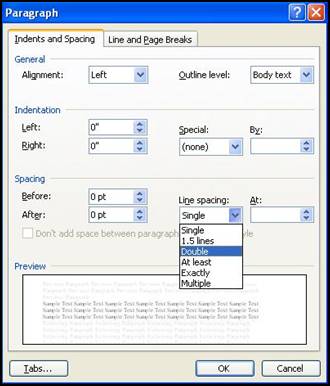INTRODUCTION, ROUGH DRAFT, AND CONCLUSION

Unit
Overview
Now that you have organized
your note cards and created your outline, you are ready to begin writing your
research paper. In this unit you will
learn how to write an introduction and conclusion for your paper. You will also write your rough draft.
Formatting
Your Research Paper
You should type your report
in Microsoft Word or another word processing program. If you are not using Microsoft Word, you
should contact your teacher to make sure that he or she can open files created
by your word processing program.

Your research paper will be at least two pages long and no longer than three pages long. Your margins should be set at 1 inch for the
top, bottom, left, and right sides.
You should double space your
writing. Does NOT double space by
pressing the Enter key at the end of each line you type. Instead, set your word processing program to
double space automatically. To do this
in Microsoft Word, open a new blank document.
Then click Format, and choose Paragraph.

When the smaller window opens, change the line spacing from
single to double. Then click OK.

Once you change this setting and set your margins, you are
ready to begin typing.
The
Introduction
The introduction is the first paragraph of your research paper. The reader gets his or her first impression
of your topic from the introduction.
That’s why the introduction needs to strongly state the purpose of your
paper.
One of the most common
mistakes that students make is writing an introduction that sounds like a
conversation. This happens when a
student uses the pronouns I and you. Below is a weak introduction that uses these
pronouns.
|
WEAK |
This is my research paper about Labrador Retrievers. I am going to tell you why having a Labrador
retriever is a good idea. I will tell
you how to take care of your Labrador retriever. You will also learn why Labrador retrievers
are such good pets.
|
While the
reader does find out what your topic is, the paragraph above does not state
your purpose strongly. Below is an
example of a stronger introduction.
Notice that this example does not use the pronouns I and you.
|
STRONG |
Labrador retrievers are one of the best dogs
that you can own. These dogs are
perfect for families with children, because they are obedient and
faithful. While owners need to love and
care for their Labrador retrievers, these dogs do not require specialized
care. These things all make Labrador
retrievers the perfect dogs for families.
|
After reading this
introduction, the reader understands that the paper will be about Labrador
retrievers. However, this introduction
lets the reader know that the author’s purpose is to show them why Labrador
retrievers are wonderful pets. This
introduction is much stronger, because it clearly states the writer’s purpose
without sounding like a conversation.
![]() Now answer question 1
Now answer question 1
The
Body
The body of your research paper is written from the information you
gathered when you did your research.
This is the main part of your research paper. This is where you share your information with
the reader.
Things to remember as you
write:
|
|
To write the body of your
research paper, look again at your outline.
Follow the order of the information you listed on your outline. Each topic will be at least a paragraph. Use the subtopics and details to help you
write the paragraph. |
|
|
|
|
|
As you are writing, refer
back to your note cards. You organized
these note cards into categories. Now
you can turn each category into a paragraph or two in the body of your paper. Use the note cards to help you write. |
|
|
|
|
|
Remember to not write down
word-for-word what you found when you researched. You need to write the information in your
own words. Otherwise, you would be
plagiarizing, or stealing someone else’s work. |
The
Conclusion
The conclusion of your research paper summarizes the main idea of your
paper. It should not include any new
information. This is your chance to
remind your reader of your main points and bring a close to your paper. Like the introduction, the conclusion should
not use the pronouns I and you. Use this as your last opportunity to make a
strong impression on your reader.
Sentence
Variety
As you write your research
paper, make it your goal to use many different kinds of sentences. This makes your paper more interesting to the
reader.
Below are examples of two
different ways to say the same thing.
|
|
Example 1: Labrador retrievers need
lots of love. Owners need to take care
of their dogs. Labrador retrievers do
not need specialized care. |
|
|
Example 2: While owners need to love
and care for their Labrador retrievers, these dogs do not require specialized
care. |
Both examples give the same
information. However, Example 1 uses
sentences that are short and choppy.
Example 2 puts the information together into a more interesting
sentence. Try to mix shorter sentences
with longer ones so that you hold your reader’s interest.
Writing
Your Rough Draft
Now you are ready to begin
writing the body and conclusion of your research paper. Keep in mind that this is your rough draft. This is the time for you to get your ideas
down on paper, not the time to worry about writing a perfect paper. You will be
revising and editing your work in later units.
You will now use
the information from your outline to write a research paper. The
information you have following a Roman numeral will be
the information within your paragraph. Use complete sentences and vary
the sentence structure. Begin sentences in different ways (e.g., begin
with a prepositional phrase, begin with an adverb). A simple sentence has
a subject and a verb. A compound sentence is a sentence with two simple
sentences connected with a conjunction. A complex sentence includes an
adverb or adjective clause (e.g., who is the man I knew (adj) or when I went to
New York (adv). Make your sentences interesting to your reader. Be
sure to include an introduction and a conclusion. No new information
should be in the conclusion paragraph. Each paragraph needs a topic
sentence. All the paragraphs should contain information relating to your
thesis statement. You should use some quotes from your sources to prove
some of your information. Include a bibliography or works cited page at
the end of your paper.
SAMPLE INTRODUCTORY PARAGRAPH:
Arthur Conan Doyle created a unique,
inimitable detective character in Sherlock Holmes and a perfect foil for his
detective in the character of his “sidekick,” Dr. John Watson. Sherlock Holmes
and Watson burst upon the scene in A Study in Scarlet, and in the canon of
Doyle’s fifty-six stories and four novels, the characterization of and
relationship between Holmes and Watson are further developed. At first glance,
Holmes may seem exasperatingly stubborn and irritatingly conceited to the
reader, and Watson may appear a slavishly loyal if not-too-bright assistant to
the great detective -- two characters who are opposite in all ways. However,
the relationship is actually a symbiotic one; Holmes and Watson are essential to
one another. Holmes is the coldly analytical reasoning mind, the “head,” while
Watson is the trustingly loyal, admiring, warm “heart.” Holmes’s stubbornness
and conceit are tempered by Watson’s loyalty and attempt at emulation of
Holmes’s methods. Watson’s naiveté and lack of acuity are balanced by Holmes’s
perceptiveness. Their personality traits complement each other and, together,
determine how Doyle meant the reader to view his characters.
SAMPLE BODY PARAGRAPHS:
Dr. John Watson admires Holmes greatly, and
strives to imitate him; the sincerest form of flattery, although Holmes
frequently criticizes Watson’s attempts. When Watson picks up the walking stick
left by a visitor, he states, “'I think,’ said I, following as far as I could
the methods of my companion, ‘that Dr. Mortimer is a successful, elderly
medical man, well-esteemed, since those who know him give him this mark of
their appreciation” (Hound 9). Holmes explains, “I am afraid, my dear Watson,
that most of your conclusions were erroneous. When I said that you stimulated
me, I meant, to be frank, that in noting your fallacies, I was guided towards
the truth” (11). Later, when Holmes tells Henry Baskerville that he himself
cannot go to Dartmoor to investigate the mystery, but that Watson could go in
his place, Watson is surprised since he had not been consulted, but immediately
agrees, feeling proud that Holmes has recommended him. He says, “The
proposition took me completely by surprise, but before I had time to answer,
Baskerville seized me by the hand and wrung it heartily. . . I was
complimented by the words of Holmes. . .” Despite all of his
attempts at Holmesian observation and deduction and his obvious admiration of
his mentor, Watson frequently receives criticism rather than praise.
In “The Adventure of the Speckled Band,”
Watson states, “I had no keener pleasure than in following Holmes in his
professional investigations, and in admiring the rapid deductions -, as swift
as intuitions, . . . with which he unraveled the problems which
were submitted to him” (18). In another story, Watson examines an unsigned
letter sent to Holmes and “endeavors to imitate my companion’s processes”
(“Scandal” 110). However, Holmes scolds Watson, “You have not observed. Yet you
have seen” (110). Watson’s admiration for and imitation of Sherlock Holmes,
despite Holmes’s frequent criticism of his attempts, creates a sense of awe in
the reader. Watson is an intelligent but “average” man, like the average
reader, so we identify with him. We look up to Holmes, in part, because
of Watson’s reverent presentation of him. Watson’s detailed and effective
chronicling of the adventures of Holmes is imbued with his respect for the
great detective. In his preface to The Complete Sherlock Holmes, one critic
notes, “We must have Watson, too. Rashly, in later years, Holmes twice
undertook to write stories for himself. They have not the same magic” (Morley
8). Watson’s loyal admiration of Holmes shows the reader that Doyle meant for
us to “overlook” Holmes’s single-minded inflexibility. Once again, Watson’s
approval tempers the reader’s possible negative response to Holmes.
Note that in the above sample
body paragraphs, most of the quotations come from Doyle’s original stories, so
only the abbreviated title of the work, plus the page number is needed. If the
title of the work has already been mentioned in the sentence, no repetition is
necessary. Only the page number appears in the parenthetical reference. The
final quotation in the paragraph is from a critic, so the critic’s last name
and the page number are cited.
SAMPLE CONCLUDING PARAGRAPH:
Arthur Conan Doyle created a unique detective
character in Sherlock Holmes and a perfect contrast for him in the character of
his loyal assistant, Dr. John Watson, yet the purpose of these two characters
is not just to provide a study in contrasts. While the reader may find Holmes
exasperatingly stubborn and irritatingly conceited at times, one must see him
through Watson’s eyes and thereby admit that Holmes demonstrates truly
phenomenal insight, powers of observation and intelligence. Watson’s admiration
of Holmes’s abilities to the point of emulation, and his loyalty, even in the
face of Holmes’s brusque manner, provides a counterpoint and shows the reader
how Doyle wants us to view his obstinate, egotistical super-sleuth -- as
believable and human despite his superhuman powers of observation and
deduction. Without Watson, Holmes would be too coldly analytical and harsh.
Without Holmes, Watson’s good-hearted, trusting nature and lack of analytical
powers would always lead him to the wrong conclusions. They “need” one another.
It is the balance provided by the two personalities that has endeared Doyle’s
Sherlock Holmes stories to millions of fans, world-wide, for over one hundred
years.
![]() Now answer questions 2 - 3
Now answer questions 2 - 3






